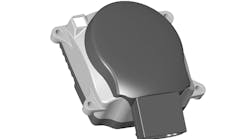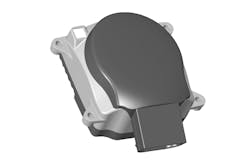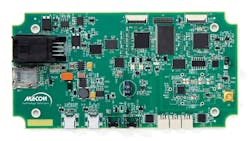Automobiles and automotive markets represent a growing area of opportunity for suppliers of high-frequency components and hardware. Just look at wireless safety products: Many newer cars are being designed with short-range sensors operating at 24 GHz and adaptive-cruise-control (ACC) and long-range forward-looking radar systems at 77 GHz. These transmitter and receiver devices rely on dependable high-frequency integrated-circuit (IC) processes that are also competitive enough to support products in a wide range of automotive markets. So far, achieving reliable performance at 77 GHz has not been a hurdle for a growing number of IC manufacturers and high-frequency companies supporting automotive RF/microwave applications.
The frequency band from 76 to 77 GHz has proven to be attractive for a number of automotive radar-based safety applications, including for adaptive cruise control (ACC), blind-spot detection (BSD), emergency braking, forward collision warning (FCW), and rear collision protection (RCP). Freescale Semiconductor, for example, has used its silicon-germanium (SiGe) BiCMOS semiconductor process as the basis for its Xtrinsic brand model PRDTX11101 VCO+Tx voltage-controlled oscillator (VCO) and transmitter combination IC for 77-GHz automotive ACC and long-range radar applications—as well as for shorter-range applications, such as BSD and cross traffic alerts.
The PRDTX11101 SiGe radar transmitter includes an on-chip frequency divider with output ports for frequency control. It can operate with a single +3.3-VDC supply (with only 1.5-W power consumption) and support short-range (to 20 m) as well as long-range (to 200 m) automotive radar applications at 77 GHz. It features low phase noise of -93 dBc/Hz offset 1 MHz from a 77-GHz carrier, and can produce two outputs at +13 dBm and 77 GHz. The IC incorporates an amplifier circuit that maintains stable current consumption during activation and de-activation of the radar pulses to minimize thermal drift of the oscillator signal. The device has an on-chip temperature sensor to maintain consistent performance by monitoring device temperature and making gain adjustments, and uses a peak power detector for enhanced transmitter efficiency by applying open- and closed-loop output power control.
Infineon has also developed a high-frequency (200-GHz) SiGe semiconductor process for automotive applications, which it uses as the basis for its Radar System IC (RASIC™) series of components for applications in the 76 to 77 GHz range. The product line includes voltage-controlled oscillators (VCOs) and dielectric resonator oscillators (DROs) as well as complete automotive radar transceiver functions for ACC and collision-warning applications. The devices are available as unpackaged bare die. For example, the model RXN740 single-chip transceiver includes all of the core functions of a radar front end, such as a VCO, transmit power amplifier, and as many as four frequency mixers, as well as on-chip test functions. With the device, a radar sensor manufacturer can produce a four-channel monostatic radar system for long-range (such as ACC) automotive radar applications at 76 to 77 GHz, taking advantage of the chip’s self-test and diagnosis functions to monitor temperatures and output levels. The radar IC is usable across the full temperature range from -40 to +125°C; it has full automotive qualification according to Automotive Electronic Congress (AEC) AEC-Q100 requirements.
TriQuint Semiconductor supports automotive radar sensor designers with a variety of 77-GHz GaAs monolithic-microwave-integrated-circuit (MMIC) products for ACC and FCW applications. The function-specific devices allow system designers to develop customized transmit and receive configurations at 77 GHz. As an example, model TGA4705-FC is a flip-chip low-noise amplifier (LNA) that is usable from 72 to 80 GHz. Based on 0.13-μm GaAs pseudomorphic-high-electron-mobility-transistor (pHEMT) technology, the amplifier has nominal noise figure of 6 dB from 76 to 77 GHz and nominal gain of 23 dB from 76 to 77 GHz. The LNA chip measures just 2.24 × 1.27 × 0.38 mm and operates on typical drain voltage of +2.5 VDC, typical drain current of 60 mA, and typical gate voltage of +0.18 VDC.
For larger signals, the company’s model TGA4706-FC flip-chip medium-power amplifier is designed for applications from 76 to 83 GHz. It offers 15-dB gain at 77 GHz with saturated output power of +14 dBm at that frequency. Also based on 0.13-μm GaAs pHEMT technology, the chip measures 1.86 × 1.37 × 0.38 mm and runs on typical drain voltage of +3.5 VDC, gate voltage of +0.2 VDC, and quiescent drain current of 125 mA.
TriQuint also offers the model TGC4702-FC,a flip-chip downconverting in-phase/quadrature (I/Q) mixer for automotive radar applications. It covers RF and local oscillator (LO) ranges of 75 to 82 GHz and an intermediate-frequency (IF) range of DC to 100 MHz. The mixer achieves RF-LO isolation of 18 dB at 77 GHz with 12-dB conversion loss at 77 GHz. The mixer chip, which measures 2.46 × 1.89 × 0.38 mm, is based on GaAs heterojunction-bipolar-transistor (HBT) technology. It is rated for maximum bias current of 15 mA at +2 VDC bias voltage.
TRW Automotive, a company with a long history of semiconductor development, offers automotive radar solutions at both 77 and 24 GHz. For example, the model AC3 77-GHz long-range radar (Fig. 1) provides outstanding speed resolution at distances as far as 250 m. The firm’s cost-effective model AC100 midrange radar system operates at 24 GHz and provides ACC and FCW functionality. The high-end model AC1000 is a scalable 77-GHz platform that provides a full 360-deg. sensing capability. All three of the automotive radar systems are capable of operating under all weather conditions.
1. Model AC3 is an automotive radar system working at 77 GHz that can detect “targets” as far as 250 m. (Photo courtesy of TRW Automotive.)
Of course, not all opportunities for electronic devices in automotive applications require such high frequencies. For some time, Toshiba (www.toshiba.co.jp) has produced ICs for automotive remote-keyless-entry (RKE) applications, including the model TB31372FNG receiver IC for the 315-MHz band and the model TC32306FTG receiver IC for the 434-MHz band. Both chips work with an IF of 220 kHz and feature on-chip IF filters with 300-kHz bandwidth, detector circuits, and on-chip VCO with phase-locked-loop (PLL) circuitry. The RKE ICs are supplied in 24-pin SSOP housings.
The model PQJ7910 variable intelligent polling receiver (ViPER) from NXP Semiconductors operates within Industrial-Scientific-Medical (ISM) band frequencies to support car access and tire-pressure monitoring system (TPMS) applications. The device features a programmable state machine and a polling timer, so it can operate autonomously while waiting for access signals from car keys and TPMS transmitters. The device’s programmable channel filter enables optimum performance for all possible protocols and applications. Model PQJ7910, which is designed for operating temperatures from -40 to +105°C, is available in versions for use from 315 to 915 MHz or 434 to 915 MHz.
The models ATA5830 and ATA5780 are transceiver and receiver ICs designed for multiband use at ISM frequencies of 310 to 318 MHz, 418 to 477 MHz, and 836 to 928 MHz for a variety of wireless automotive applications. These include RKE, remote start, passive entry go (PEG), and tire-pressure-monitoring-system (TPMS) applications. The devices combine receiver or transceiver circuitry with a microcontroller core, enabling each device to poll multiple application channels to create a cost-effective automotive electronics remote control. The two ICs are pin-compatible devices to simplify their reuse in one-way and two-way automotive access systems. They are each supplied in a 5 × 5 mm QFN32 package and draw very little current in their power-down states, thereby conserving battery life.
2. The eHorizon module combines a processor, GPS receiver, and electronic map to provide a “look ahead” on a road. (Photo courtesy of M/A-COM Technology Solutions.)
Lastly, the Advanced Driver Assist System (ADAS) eHorizon module from M/A-COM Technology Solutions is a board-level automotive electronic product that functions more like an “assistant driver” than an electronic aid. The module (Fig. 2), which integrates a Global Positioning System (GPS) receiver and microprocessor along with a NAVTEQ map, attempts to plot upcoming road features to improve the quality and safety of a driver’s ride. Using the map and GPS information, the processor works with an automobile’s systems to save fuel, reduce carbon-dioxide emissions, and boost the efficiency of an automobile for a given travel route. Although high-frequency electronics cannot yet tell the future, this is one module that certainly prepares an automobile for what roads lie ahead.


